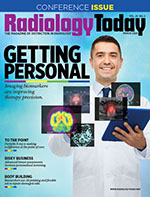 Editor’s Note: Step by Step
Editor’s Note: Step by Step
By David Yeager
Radiology Today
Vol. 25 No. 2 P. 4
Personalized care has been a buzzword in health care for a few years, but what will it look like? As you may have guessed, there is no single answer. The promise and challenge of personalized care is that it will be tailored to individuals. While there is still much work to be done, strides are being made in this direction. The advances come in many shapes and sizes, but taken together, they reflect genuine progress. This month’s issue highlights several steps in the direction of personalized care.
In our cover feature, Claudia Stahl reports on some of the latest advances in personalized nuclear medicine. New tools such as theranostics are allowing treatment to be targeted in ways that were not previously possible. There has been significant progress in using theranostics to treat prostate, breast, and neuroendocrine cancers, but another exciting application of this technology is showing promise for treating neurological disorders. Recently, there has been progress not only in treating disorders related to accumulation of amyloid and tau aggregates, such as Alzheimer’s disease and Parkinson’s disease, but also disorders related to alpha-synuclein aggregates, such as dementia with Lewy bodies and multiple system atrophy.
A technology that’s changing the way health care is delivered is handheld DR. These systems provide portability and flexibility in remote or underserved areas. They can be used for screenings or within health care facilities where moving patients is a less desirable option, such as nursing homes. They’re also useful for fast diagnoses at sporting events. Keith Loria has a round-up of some of the latest developments.
Risk assessment is another aspect of personalized care. Rebecca Montz has an update on advances in breast density assessment and new tools for estimating a woman’s risk of breast cancer. Because breast density assessments vary by radiologist, tools that help quantify the density of breast tissue are becoming more important. There are other factors that affect risk, however, and analyzing all of that data helps form a clearer picture of individual risk.
Finally, Beth W. Orenstein looks at a new method of 3D printing that may one day allow highly specific treatments without the need for open surgery. The technique uses an ink that’s activated by ultrasound waves, allowing researchers to create flexible and biocompatible structures inside bodies. Although still in the experimental stages, the researchers are optimistic that the technique will be transferable to humans, making a new line of minimally invasive procedures available. Turn to page 24 for details.
Enjoy the issue.
— Dave Yeager
david.yeager@gvpub.com

